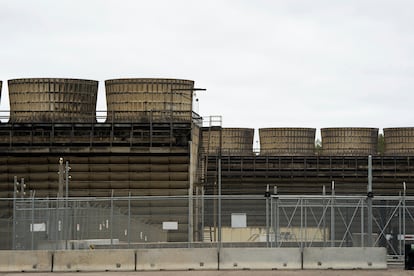Regulators monitor tritium leak at Minnesota nuclear plant
The company says it took swift action to contain the leak to the plant site, and there’s no health and safety risk to the local community or the environment

Minnesota regulators said Thursday they’re monitoring the cleanup of a leak of 400,000 gallons of radioactive water from Xcel Energy’s Monticello nuclear power plant, and the company said there’s no danger to the public.
“Xcel Energy took swift action to contain the leak to the plant site, which poses no health and safety risk to the local community or the environment,” the Minneapolis-based utility said in a statement.
While Xcel reported the leak of water containing tritium to state and federal authorities in late November, the spill had not been made public before Thursday. State officials said they waited to get more information before going public with it.
“We knew there was a presence of tritium in one monitoring well, however Xcel had not yet identified the source of the leak and its location,” Minnesota Pollution Control Agency spokesman Michael Rafferty said.
“Now that we have all the information about where the leak occurred, how much was released into groundwater, and that contaminated groundwater had moved beyond the original location, we are sharing this information,” he said, adding the water remains contained on Xcel’s property and poses no immediate public health risk.
The company said it notified the federal Nuclear Regulatory Commission and the state on Nov. 22, the day after it confirmed the leak, which came from a pipe between two buildings. Since then, it has been pumping groundwater, storing and processing the contaminated water, which contains tritium levels below federal thresholds.
“Ongoing monitoring from over two dozen on-site monitoring wells confirms that the leaked water is fully contained on-site and has not been detected beyond the facility or in any local drinking water,” the Xcel Energy statement said.
The Monticello plant is about 35 miles (55 kilometers) northwest of Minneapolis, upstream from the city on the Mississippi River.
Tritium is a radioactive isotope of hydrogen that occurs naturally in the environment and is a common by-product of nuclear plant operations. It emits a weak form of beta radiation that does not travel very far and cannot penetrate human skin, according to the NRC. A person who drank water from a spill would get only a low dose, the NRC says.
The NRC says tritium spills happen from time to time at nuclear plants, but that it has repeatedly determined that they’ve either remained limited to the plant property or involved such low offsite levels that they didn’t affect public health or safety. Xcel reported a small tritium leak at Monticello in 2009.
Xcel said it has recovered about 25% of the spilled tritium so far, that recovery efforts will continue and that it will install a permanent solution this spring.
“While this leak does not pose a risk to the public or the environment, we take this very seriously and are working to safely address the situation,” Chris Clark, president of Xcel Energy–Minnesota, North Dakota and South Dakota, said in the statement. “We continue to gather and treat all potentially affected water while regularly monitoring nearby groundwater sources.”
Xcel Energy is considering building above-ground storage tanks to store the contaminated water it recovers, and is considering options for the treatment, reuse, or final disposal of the collected tritium and water. State regulators will review the options the company selects, the MPCA said.
Japan is preparing to release a massive amount of treated radioactive wastewater into the sea from the triple reactor meltdowns 12 years ago at the Fukushima Daiichi nuclear power plant. The water contains tritium and other radioactive contaminants.
Sign up for our weekly newsletter to get more English-language news coverage from EL PAÍS USA Edition
Tu suscripción se está usando en otro dispositivo
¿Quieres añadir otro usuario a tu suscripción?
Si continúas leyendo en este dispositivo, no se podrá leer en el otro.
FlechaTu suscripción se está usando en otro dispositivo y solo puedes acceder a EL PAÍS desde un dispositivo a la vez.
Si quieres compartir tu cuenta, cambia tu suscripción a la modalidad Premium, así podrás añadir otro usuario. Cada uno accederá con su propia cuenta de email, lo que os permitirá personalizar vuestra experiencia en EL PAÍS.
¿Tienes una suscripción de empresa? Accede aquí para contratar más cuentas.
En el caso de no saber quién está usando tu cuenta, te recomendamos cambiar tu contraseña aquí.
Si decides continuar compartiendo tu cuenta, este mensaje se mostrará en tu dispositivo y en el de la otra persona que está usando tu cuenta de forma indefinida, afectando a tu experiencia de lectura. Puedes consultar aquí los términos y condiciones de la suscripción digital.
More information
Archived In
Últimas noticias
Cubans look to Venezuela fearfully after Trump’s incursion: ‘We could be next’
The operation in Venezuela to capture Maduro threatens to widen the cracks in the MAGA movement
Trump clarifies who is ultimately in charge in Venezuela: ‘Me’
Maduro pleads not guilty before the federal court in New York: ‘I am still the president of Venezuela’
Most viewed
- Alain Aspect, Nobel laureate in physics: ‘Einstein was so smart that he would have had to recognize quantum entanglement’
- Gilles Lipovetsky: ‘If you want to live better and fall in love, take Prozac, don’t look to philosophy’
- Alvin Hellerstein, a 92-year-old judge appointed by Bill Clinton, to preside over Maduro’s trial in New York
- Cuba confirms death of 32 of its citizens in the US attack against Venezuela
- Why oil has been at the center of Venezuela-US conflicts for decades










































